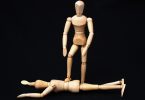Number 3: Emergency Escape Bags: The Need for Control
Creating emergency escape bags, you’re safe now, okay? But your body does not believe it. So, you keep a small bag packed with clothes, money, ID, phone charger,and meds just in case. You might hide it under the bed, in the car, or behind the closet. No one knows it is there, not even your conscious mind most of the time. But it gives you a sense of control, a weird one: a backup plan, an exit strategy. What is the reason? Because when you have been trapped once, freedom never feels permanent. You sleep lighter, you double-check locks, you plan your exits in public places. And the bag? Of course, that’s not paranoia; that’s your body saying, “This time, if I have to run, I will be ready.”
Number 4: Repetitive Clothing: Seeking Safety in Familiarity
You would think freedom would bring out experimentation, like new styles, bold choices, and fresh colors. But for many survivors, it is just the opposite. They wear the same outfit every day: the same hoodie, same jeans, same shoes. Sometimes it’s because that outfit reminds them of the first day they felt free. Other times, it’s because they do not want to be seen; they do not want to draw attention, compliments, or judgment. It’s a kind of armor, a camouflage, a familiarity in a world that suddenly feels too big and too bright. When you have been constantly criticized for how you look, what you wear, and how much you reveal, your wardrobe stops being about self-expression. It becomes about safety. And until that safety is internalized, fashion takes a backseat to survival.
Continue reading on the next page
Sharing Is Caring!





